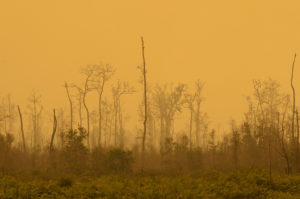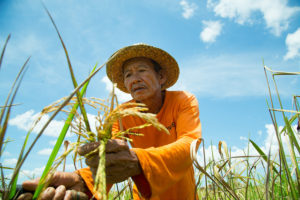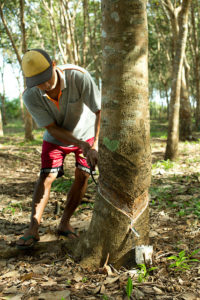Indonesia – Deep in the forests of Central Kalimantan, Indonesia, the murmur of a paddle sliding through water joins the mesh of bird song. Lined on all sides by clouds of vegetation, Adam is maneuvering his wooden canoe through the peat-soaked river. Light begins to sift through the leaves. The day’s fishing has begun.
Adam catches up to 10 kilograms of sheatfish, kissing gourami and giant mudfish a day, making roughly 50,000 Indonesian rupiah (US$4). His family has lived in Parupuk village for decades. As fishermen, they exist in close relation with the peat and the waters that flood it.
“If there were no lakes like this, we’d be in trouble. We wouldn’t be able to eat,” he says.
The practice of draining, clearing and burning peatlands in this part of Indonesia – to clear space for agricultural plantations like palm oil and pulp wood – is putting Adam’s livelihood in jeopardy. As peat is extinguished, so is the water that naturally sustains it, along with its aquatic inhabitants.
“That peatland over there already has no water,” says Adam, pointing his finger across the horizon.

Tough tactics
So-called slash and burn techniques – designed to clear land, eradicate pests, and fertilize ground with ash – have often spread into vast forest fires in Indonesia. They can smoulder for weeks on peatlands, which are highly flammable once dried and degraded.
The smoke and flames lead to devastating consequences for human health, endangered animals and plants, as well as the environment. The fires in September and October of 2015 in Indonesia alone released higher levels of carbon per day than the daily average emitted by the entire European Union over the same period.
In response, the Indonesian government introduced a series of measures designed to stop the fires. Slash and burn is now illegal, and a ban on converting peatlands to agricultural plantations has been expanded and solidified in law.
The government has also ratified the Paris Agreement on climate change, committing Indonesia to cut greenhouse-gas emissions by 29 percent by 2030, and they have launched the national Peatland Restoration Agency with the aim of restoring 2.4 million hectares of peatland in seven provinces.
A difficult balancing act
However, while many hail these restrictions (which, if enforced, should help boost the day-to-day living of fishermen like Adam), the consequences for small-scale farmers could be very different.
Authorities are facing a potential Catch-22. Could policy measures designed to protect the environment have unintended adverse effects on the local people’s livelihoods?

Alin has been successfully farming rice in Kampung Melayu village in Kalimantan for more than five years. Each year, he has cleared his paddy with fire, allowing the ashes to enrich the land for the next planting season.
But in 2017, everything changed.
“The harvest failed for the first time because I am no longer allowed to burn my land,” he says.
Alin is afraid of the long-term consequences for his family. “If it carries on like this, we’ll struggle because pests won’t be killed – like rats, rice bugs, birds, ants, caterpillars. All of them can cause harvest failure.”
And it is not just the failed harvest that is contributing to Alin’s financial worries.
“Before, when we would burn, we could just scatter the seeds and we could get rice,” he says. “Now, it’s not possible. Now, we have to pay to replant, pay to clear the grasses as well because grasses live if they’re not burned. For one hectare, it can cost 4-5 million rupiah [USD $300- $400].”
Read also: FTA seeks to influence debate at upcoming GLF on peatlands
Working together
The Indonesian government, research and civil society organizations are now taking steps to mitigate the effects of fire restrictions on individuals’ lives.
“Solutions are complex because they need to address several dimensions,” says Peter Holmgren, Director-General of the Center for International Forestry Research (CIFOR).
“They need to address people’s livelihoods and they need to address how the climate is disrupted by emissions from peatlands. The solutions also need to take into account the need for biodiversity conservation.”
Across Indonesia, a variety of schemes are in place- from bringing in local laws that can help allocate budget to assist communities, to agroforestry, where trees or shrubs are grown in agricultural land.
The Indonesian government has also introduced measures to protect local livelihoods, with plans for social forestry across 12.7 million hectares of land and reforms that will provide 9 million hectares of land to communities.

Sustainable alternatives
In Central Kalimantan, the organization Rimba Makmur Utama is running a forest regeneration project, working with farmers on a variety of tactics, including diversifying the crops they grow. They operate hand-in-hand with local people to address the concerns and priorities they identify, rather than forcing solutions.
“Communities in peatland in Indonesia are currently in a very challenging situation,” says Dharsono Hartono, CEO of Rimba Makmur Utama. “There’s no quick fix.”
One key problem raised by the local community is the need for affordable alternatives to slash and burn farming, in order to manage and fertilize their soil. Now, the organization and smallholders are introducing what are called ‘cover crops’, like local beans, which are planted after harvest. These crops feed nutrients into the soil and protect it from bacteria and infection, so that the land is ready for planting season, without the need for burning.
“Once you have increased soil productivity through proper soil management, you can plant a lot of crops,” says Hartono.
Researchers emphasize that this practice of involving the community, and working together to consider and address their needs, is vital to successfully managing peatlands and reconciling diverging interests.
On 18 May, community leaders joined environmentalists, government officials, academics and policymakers at the Global Landscapes Forum: Peatlands Matter thematic event in Jakarta, Indonesia, to move forward the discussion.
“We need to bring different sectors and different perspectives into the solutions,” said Holmgren.
By Rose Foley, originally published at CIFOR’s Forest News.
This research forms part of the CGIAR Research Program on Forests, Trees and Agroforestry.











